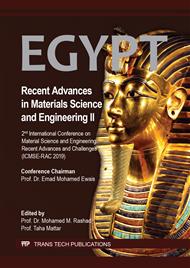[1]
V.G. Gavriljuk, H. Berns: High nitrogen steels" structure, properties, manufacture, applications, Springer- Verlag Berlin Heidelberg, Germany, (1999).
Google Scholar
[2]
M.O. Speidel and P.J. Uggowitzer: R.A. Lula (ed.), Proc. Materials Week 92, Chicago, ASM Int., p.135, (1993).
Google Scholar
[3]
ASM International, Heat Treater,s Guide Practices and Procedures for Irons and Steels Harry Chandler, Editor, copyright (1995).
Google Scholar
[4]
L. Pryce and K. W. Andrews, J. Iron Steel Inst., 195, p.415, (1960).
Google Scholar
[5]
C. Lille, R. F. A. Jargelius — Pettersson Factors affecting the oxidation mode of stainless steels, Materials at High Temperatures, 17, No.2, pp.287-292, (2000).
DOI: 10.1179/mht.2000.17.2.016
Google Scholar
[6]
M. Sagara, H. Uno, Y. Katada, T. Kodama Effect of alloying elements on localized corrosion characteristics of nitrogen-bearing stainless steels and evaluation of crevice corrosion in seawater environment,, JISI, 88, No.10, 672-677, (2002).
DOI: 10.2355/tetsutohagane1955.88.10_672
Google Scholar
[7]
M. Sagara, Localized corrosion resistance of high nitrogen stainless steel,, ISIJ Bulletin, 7, No.11, 858- 859, (2002).
Google Scholar
[8]
H. Baba, T. Kodarwa, Y. Katada Role of nitrogen on the corrosion behaviour of austenitic stainless steels,, Corrosion Science, 44, No. 10, 2393-2407, (2002).
DOI: 10.1016/s0010-938x(02)00040-9
Google Scholar
[9]
C. Issartel, H. Buscail, E. Caudron, R. Cueff, F. Riffard, S. Perrier, P. Jacquet, M. Lambertin Influence of nitridation on the oxidation of a 304 steel at 800°C ,, Corrosion Science, 46, 2191-2201, (2004).
DOI: 10.1016/j.corsci.2004.01.018
Google Scholar
[10]
C. Zappfe , Stainless steels ,ASM. , (1949).
Google Scholar
[11]
J. Cook and B. R. Brown, J. Iron Steel Inst., 171, p.345, (1952).
Google Scholar
[12]
Y. S. Lim, J. S. Kim, S. J. AIn, H. S. Known, Y. Katada The influences of microstructure and nitrogen alloying on pitting corrosion of type 3 16L and 20% Mn-subtituted type 3 16L stainless steels,, Corrosion Science, 43, No.1, 53-68, (2001).
DOI: 10.1016/s0010-938x(00)00074-3
Google Scholar
[13]
S. Tanaka, K. Yamamura and M. Oohori The development of bearing steels with long life and high corrosion resistance,, Bearing Steel Technology, ASTM Special Technical Publication, 1419, 4 14-424, (2002).
DOI: 10.1520/stp10870s
Google Scholar
[14]
M. Sagara 'Localized corrosion resistance of high nitrogen stainless steel',, ISIJ Bulletin, 7, No.11, pp.858-859, (2002).
Google Scholar
[15]
E.K. Arthur et al., Carbon and Nitrogen Concentration Profiles of Cassava-Pack Carbonitrided Steel: Model and Experiment,, Advanced Materials Research, Vol. 1132, pp.313-329, (2016).
DOI: 10.4028/www.scientific.net/amr.1132.313
Google Scholar
[16]
J. K. Shin et al., A Study of Nitrogen Effect on the Characteristics of Creep-Rupture in 18Cr-9Ni Austenitic Steels ,, Key Engineering Materials, Vols. 297-300, pp.409-414, (2005).
DOI: 10.4028/www.scientific.net/kem.297-300.409
Google Scholar
[17]
Y. S. Kim et al., Deformation Behavior of Nitrogen Bearing Austenitic Steels with Various Nitrogen Contents,, Key Engineering Materials, Vols. 345-346, pp.117-120, (2007).
DOI: 10.4028/www.scientific.net/kem.345-346.117
Google Scholar
[18]
Saeed N. Ghali , Low carbon high nitrogen low nickel stainless steel,, steel research int. 84, No.5, 450-456 (2013).
DOI: 10.1002/srin.201200152
Google Scholar
[19]
S. N. Basu, G. J. Yurek Effect of alloy grain size and silicon content on the oxidation of austenitic Fe-Cr-Ni- Mn-Si alloys in pure O2,, Oxid. Met., 36, No. 3/4, 281-315, (1991).
DOI: 10.1007/bf00662967
Google Scholar
[20]
Y. Hosoi, S. Moteki , Y. Shimoide , Y. Sasaki, K. Miyahara Effect of nitrogen, carbon, and tungsten on high - temperature oxidation of 12%Cr-15%Mn austenitic steel,, ISIJ, 36, No.7, 834-839, (1996).
DOI: 10.2355/isijinternational.36.834
Google Scholar
[21]
H. P. Leckie, H. H. Uhlig; J. Electrochem. Soc. 113, 1262-1267, (1966).
Google Scholar
[22]
F. Masuyama, K. Hiromatsu and Y. Hasegawa 'High temperature oxidation behavior of high nitrogen ferritic steels',, ISIJ International, 36, No. 7, pp.825-833, (1996).
DOI: 10.2355/isijinternational.36.825
Google Scholar


